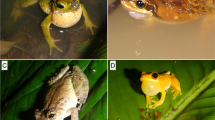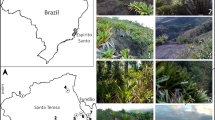Abstract
A critical challenge of obtaining a blood meal resides in selecting a feeding site at the host. We investigate the feeding sites of species of frog-biting midges (Corethrella spp) on túngara frogs, Engystomops pustulosus (Cope), and two species of treefrogs, Dendropsophus ebraccatus (Cope) and Dendropsophus microcephalus (Cope). To investigate the differences in midge feeding sites, we performed field observations, histological sections of the frogs and examined the mouthparts of the midges. Feeding sites are predicted by the vascular properties of the skin in different body areas of the frogs. According to optimal foraging theory, the midges should feed on host body areas that maximize blood intake. Contrary to optimal foraging theory predictions, however, their feeding sites correspond to body areas with high intensity host defensive behavior.



Similar content being viewed by others
References
Amato José FR, Amato SB (2005) New species of Temnocephala Blanchard (Platyhelminthes, Temnocephalida) ectosymbiont on giant water bugs, Belostoma spp. (Hemiptera, Belostomatidae) from southern Brazil. Rev Bras Zool 22:107–118
Balashov YS (1984) Interation between blood-sucking arthropods and their hosts, and its influence on vector potential. Annu Rev Entomol 29:137–156
Barrozo RB, Lazzari CR (2004) The response of the blood-sucking bug Triatoma infestans to carbondioxide and other host odours. Chem Senses 29:319–329
Bernal XE, Rand AS, Ryan MJ (2006) Acoustic preferences and localization performance of blood-sucking flies (Corethrella Coquillett) to túngara frog calls. Behav Ecol 17:709–715
Blackmore JS, Dow RP (1958) Differential feeding of Culex tarsalis on nestling and adult birds. Mosq News 18:15–17
Borkent A (2008) The frog-biting midges of the world (Corethrellidae: Diptera). Zootaxa 1804:5–350
Borkent A, Grafe TU (2012) The frog-biting midges of Borneo-from two to eleven species (Corethrellidae: Diptera). Zootaxa:1–45
Boutilier RG, Stiffler DF, Toews DP (1992) Exchange of gases, ions and water in aquatic amphibians. In: Feder ME, Burggren WW (eds) Environmental physiology of the amphibians. University of Chicago Press, Chicago
Bowen MF (1991) The sensory physiology of host seeking behavior in mosquitoes. In: Mittler, T. E., F. J. Radovsky and V. H. Resh:139–158
Braverman Y (1988) Preffered landing sites of culicoides species (Diptera, Ceratopogonidae) on a horse in Israel and its relevance to summer seasonal recurrent dermatitis (sweet itch). Equine Vet J 20:426–429
Burgess L (1959) Probing behaviour of Aedes aegypti (L.) in response to heat and moisture. Nature 184:1968–1969
Chandra G, Hati AK (1993) Correlation between the preferred biting site of Culex quinquefasciatus and the region of the body affected by clinical filariasis. Ann Trop Med Parasitol 87:393–397
Clements AN (1999) The biology of mosquitoes; Sensory reception and behavior. CABI Publishing Wallingford, Oxon
Coleman RE, Edman JD (1988) Feeding-site selection of Lutzomyia longipalpis (Diptera: Psychodidae) on mice infected with Leishmania mexicana amazonensis. J Med Entomol 25:229–233
Cully J, Heard P, Wesson D, Craig G (1991) Antibodies to La Crosse virus in eastern chipmunks in Indiana near an Aedes albopictus population. J Am Mosq Control Assoc 7:651–653
Darbro JM, Harrington LH (2007) Avian defensive behavior and blood-feeding success of the West Nile vector mosquito Culex pipiens. Behav Ecol 18:750–757
Davies CR (1990) Interrupted feeding of blood-sucking insects: causes and effects. Parasitol Today 6:19–22
De Jong R, Knols BGJ (1995) Selection of biting sites on man by two malaria mosquito species. Experientia 51:89–99
Dekker T, Takken W, Knols BGJ, Bouman E, Van de Laak S, de Bever A, Huisman PWT (1998) Selection of biting sites on a human host by Anopheles gambiae s.s., An. arabiensis and An. quadriannulatus. Entomol Exp Appl 87:295–300
Edman J, Kale H (1971) Host behavior: its influence on the feeding success of mosquitoes. Ann Entomol Soc Am 64:513–516
Edman JD, Scott TW (1987) Host defensive behavior and the feeding success of mosquitoes. Insect Sci Appl 8:617–622
Edman JD, Walker JE (1985) Vector-host interplay-factors affecting disease transmission. In: Lounibos LP, Ray JR, Frank JH (eds) Ecology of mosquitoes. Chapman & Hall, New York, pp 273–285
Gillett JD (1967) Natural selection and feeding speed in a blood-sucking insect. Proc R Soc B 167:316–329
Gillies MT (1980) The role of carbon dioxide in host-finding by mosquitoes (Diptera: Culicidae). Bull Entomol Res 70:525–532
Haarløv N (1964) Life cycle and distribution pattern of Lipoptenacervi (L.)(Dipt., Hippobosc.) on Danish Deer. Oikos 15:93–120
Haddow AJ (1946) The mosquitoes of Bwamba County. Uganda Bull Entomol Res 37:57–82
Haddow AJ (1956) Observations on the biting-habits of African Mosquitos in the Genus Eretmapodites Theobald. Bull Entomol Res 46:761–772
Hocking B (1971) Blood-sucking behavior of terrestrial arthropods. Annu Rev Entomol 16:1–26
Howard MMD, Khan AA, Walter G, Strauss MD, Skinner WA (1969) Human skin in relationship to mosquito attraction and repulsion. Conn Med 33:23–28
Ibañez R, Rand AS, Jaramillo CA (1999) Los anfibios del Monumento Natural Barro Colorado, ParqueNacionalSoberanía y areas adyacentes. Mizrachi. E and SA Pujol, Santa Fe de Bogota
Kelly DW (2001) Why are some people bitten more than others? Trends Parasitol 17:578–581
Khan AA, Maibach HI (1966) Quantitation of effect of several stimuli on landing and probing by Aedes aegypti (L).J. Econ Entomol 59:902–905
Klowden M, Lea A (1978) Blood meal size as a factor affecting continued host-seeking in Aedes aegypti (L.). Am J Trop Med Hyg 27:827–831
Knols BGJ, Takken W, Cork A, De Jong R (1997) Odour-mediated host-seeking behaviour of Anopheles mosquitoes: a new approach. Ann Trop Med Parasitol 91:117–118
Kweka E, Mwang’onde B, Lyaruu L, Tenu F, Mahande A (2010) Effect of different hosts on feeding patterns and mortality of mosquitoes (Diptera: Culicidae) and their implications on parasite transmission. J Glob Infect Dis 2:121–123
Lall SB, Davies DM (1971) An intergeneric comparison of cephalic structure in Tabanids (Diptera) in relation to feeding habits. J Med Entomol 8:700–706
Lehane M (2005) The biology of blood sucking insects. Cambridge University Press, London
Luna LG (1968) Manual of histological staining methods of the Armed Forces Institute of Pathology. Mc Graw Hili, New York, pp 9–20
MacArthur RH, Pianka ER (1966) On the optimal use of a patchy environment. Am Nat 100:603–609
Magnarelli LA, Anderson JF (1980) Feeding behavior of Tabanidae (Diptera) on cattle and serologic analyses of partial blood meal. Environ Entomol:664–667
McKeever S (1977) Observations of Corethrella feeding on tree frogs (Hyla) Mosq. News 37:522–523
McKeever S (1986) Mouthparts of the four North American Corethrella species (Diptera: Chaoboridae), with Detailed study of C. appendiculata. J Med Entomol 23:502–512
McKeever S, French FE (1991) Corethrella (Diptera, Corethrellidae) of eastern North America:laboratory life history and field responses to anuran calls. Ann Entomol Soc Am 84:493–497
McKeever S, Hagan DV, Grogan WL (1995) Comparative study of mothparts of predaceous midges of the tribe Palpomyiini (Diptera, Ceratopogonidae) from eastern-United-States. Proc Entomol Soc 97:799–832
Mullens BA, Gerhardt RR (1979) Feeding behavior of some Tennessee Tabanidae. Environ Entomol 8:1047–1051
Murray MD (1987) Effects of host grooming on louse populations. Parasitol Today 3:276–278
Murray M, Nicholls D (1965) Studies on the ectoparasites of seals and penguins. in The ecology of the louse Lepidophthirus macrorhini Enderlein on the southern elephant seal, Mirounga leonina (L). Aust J Zool 13:437–454
Nicolas G, Sillans D (1989) Immediate and latent effects of carbon dioxide on insects. Annu Rev Entomol 34:97–116
Prior A, Torr S (2002) Host selection by Anopheles arabiensis and An. quadriannulatus feeding on cattle in Zimbabwe. Med Vet Entomol 16:207–213
Ryan MJ (1985) The túngara frog, a study in sexual selection and communication. University of Chicago Press, Chicago
Ryan MJ, Rand AS (1990) The sensory basis of sexual selection for complex calls in the túngara frog, Physalaemus pustulosus Behav. Ecol. Sociobiol. (Sexual selection for sensory exploitation). Evolution 44:305–314
Sirinivas SD, Selvaraj RP, Dwarakanath SK (1994) Biting behavior of Armigeres subalbatus (Coquillett) with reference to host selection and landing. Indian J Exp Biol 32:348–350
Sutcliffe JF, McIver SB (1984) Mechanics of blood-feeding in black flies (Diptera, simuliidae). J Morphol 180:125–144
Townley P, Baker KP, Quinn J (1984) Preferential landing and engorging sites of Culicoides species landing on a horse in Ireland. Equine Vet J 16:117–120
Wahid I, Sunahara T, Mogi M (2003) Maxillae and mandibles of male mosquitoes and female autogenous mosquitoes (Diptera: Culicidae). J Med Entomol 40:150–158
Walker ED, Edman JD (1985) Feeding-site selection and blood-feeding behavior of Aedes triseriatus (Diptera, Culicidae) on rodent (Sciuridae) hosts. J Med Entomol 22:287–294
Wang G, Qiu Y, Lu T, Kwon H, Pitts R, Van Loon J, Takken W, Zwiebel L (2009) Anopheles gambiae TRPA1 is a heat-activated channel expressed in thermosensitive sensilla of female antennae. Eur J Neurosci 30:967–974
Webber LA, Edman JD (1972) Anti-mosquito behaviour of ciconiiform birds. Anim Behav 20:228–232
Wells KD (2007) The ecology and behavior of amphibians. University of Chicago Press, Chicago
Acknowledgments
We are thankful to Lewis Held for his help and advice with the midge dissections and Art Borkent for his suggestions that helped improve this work. We are also grateful to two anonymous reviewers that provided valuable comments to improve this manuscript. The Smithsonian Tropical Research Institute provided critical logistic support. We are also thankful to the ANAM (Autoridad Nacional del Ambiente, Panama) which provided the required permits to collect and export specimens (No. SE/A-50-09, No. SEX/A-60-09). This work was supported by the National Science Foundation (NSF) grant IOS-1258039 to X.E.B.
Author information
Authors and Affiliations
Corresponding author
Rights and permissions
About this article
Cite this article
de Silva, P., Jaramillo, C. & Bernal, X.E. Feeding Site Selection by Frog-Biting Midges (Diptera: Corethrellidae) on Anuran Hosts. J Insect Behav 27, 302–316 (2014). https://doi.org/10.1007/s10905-013-9428-y
Revised:
Accepted:
Published:
Issue Date:
DOI: https://doi.org/10.1007/s10905-013-9428-y




